The Amazing Amaru Bioparque
This post may contain affiliate links. If you make a purchase through these links, we will earn a small commission at no extra cost to you. For more information, please check our privacy policy. Thanks!
If you enjoy hiking and love animals, Cuenca, Ecuador, has the perfect place for you. It’s the Amaru Bioparque. You can spend hours there, working your way up and down the side of a mountain as you visit hundreds of species of animals.
Steve and I were delighted with Amaru Bioparque when we visited Cuenca in 2019. We spent a total of eight hours there over two days. We have many fond memories of our ten months in Latin America, and this was among our favorites. You can read about them in Our Top 10 Latin American Travel Experiences.
What is Amaru Bioparque?
It is a sanctuary for animals that have been rescued and, despite rehabilitation, cannot be returned to the wild. At Amaru, these animals can live out their lives in a natural environment.
Amaru receives about 450 animals every year. They come from illegal hunting, illegal trafficking of species, seizures by the National Police, and donations by civilians. The large number of animals received at Amaru is because it is the only wildlife clinic in the south of the country.
From the Amaru Bioparque website:
“We are an environmental zoological organization that offers a unique experience with the animals and plants that are a part of Ecuador´s natural and cultural richness. We promote and run education, communication, recreation, and research programs to foster the conservation of Ecuador’s biodiversity.”
The setting is rustic. You will hike over 2 km of dirt paths carved into the side of a mountain as you learn about the animals and their habitats. You will traverse hills and less-than-ideal steps cut into the dirt. Sturdy shoes are a must.

There are many signs throughout the park with information about the animals and their native environments. When we visited, most of the signs were in Spanish, but a few had English translations. The lack of English wasn’t a problem. We could understand quite a bit, and when we couldn’t, we used Google Translate.
Arriving at Amaru
Amaru is located about 5 miles (7 km) from the historic center of Cuenca. It is easy to get to the park via car or taxi. The round trip cost for taxis was US$12.00 in 2019. When you are finished with your visit, the ticket booth attendant can arrange a taxi for you.
You can also get near the park by bus, but you will have quite an uphill walk before you reach the entrance. I recommend a taxi over a bus.
You will probably want to take a few minutes to enjoy the views of the city as you enter the park.

When you arrive, you should receive a map. Pay attention to it. It shows the path through the park. On our first visit, Steve and I failed to do this. After about an hour and a half, we looked at the map and realized that we were only a quarter of the way through. Since it was late afternoon by that time, we backtracked our way to the entrance.
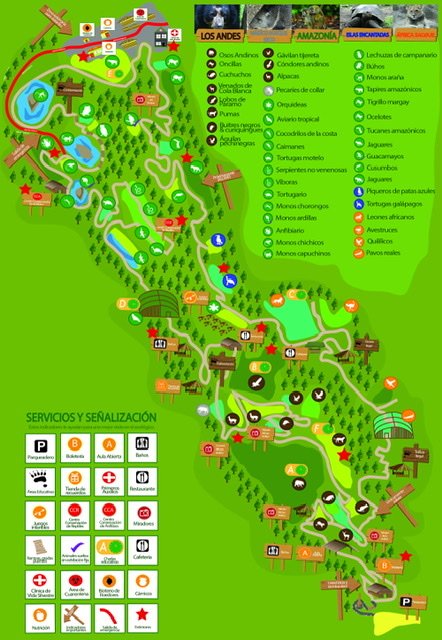
Here is the link to the map on the website.
We returned two weeks later so we could see the rest of the park. Now older and wiser, we arrived early in the morning and paid more attention to the map.
You cannot take food, pets, or large bags into the park. I was allowed to take my backpack because it was small, but it had to be inspected first. There is a place about halfway along the trail where you can buy drinks and snacks. There are some restrooms as well.
Some of the Animals You Will See
Andean Bear
One of the first animals you will encounter is the Andean or Spectacled Bear. The six Andean Bears that currently live in Amaru have a habitat that is greater than 37,000 sq. ft. (3,500 sq. meters). They are solitary animals. We only saw one each time we visited.
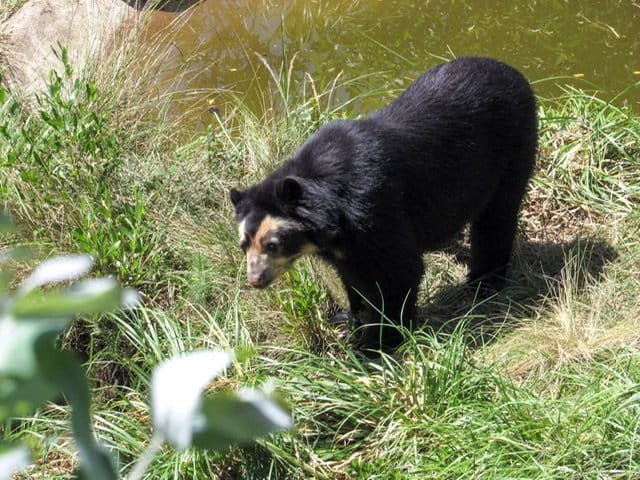
White Capuchin Monkey
You can see these adorable monkeys (the park has four) traveling through wire tubes set among the trees. There is no guarantee you won’t get an unwanted shower.

Squirrel Monkey
Delightful squirrel monkeys roam free in the park. As you might expect, they love to hang around the restaurant area, but I didn’t see them bothering anyone.
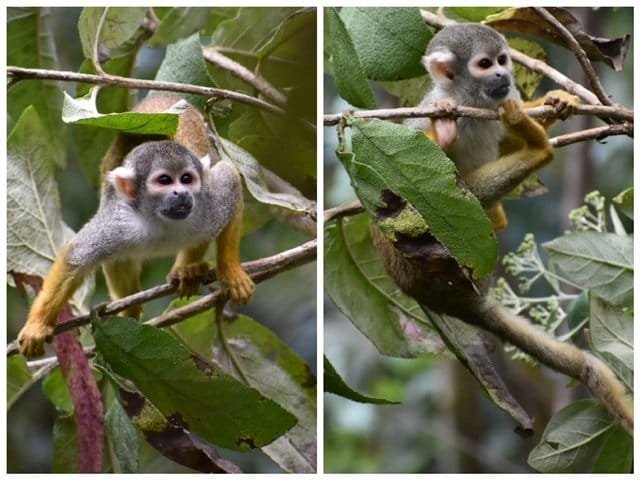
Capybara
The park has five capybaras, the largest rodent in the world. I always love seeing them.

Cuchucho
This cuchucho is a native to Lain America and is not threatened.
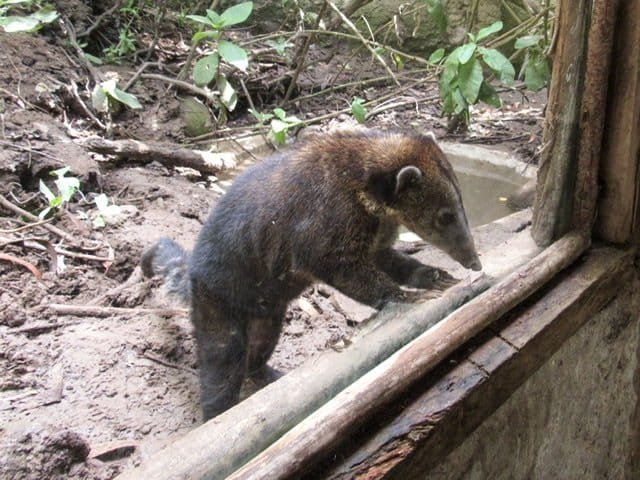
Oncilla
This little cutie is a Latin American native and the smallest feline in Ecuador.
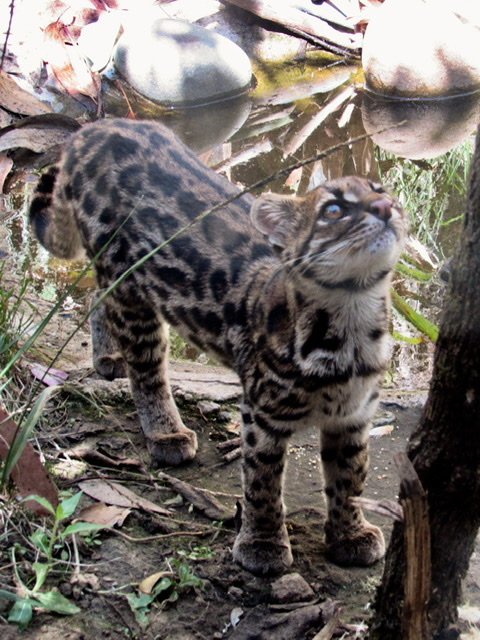
African Lion
As we worked our way through the park, we saw many familiar animals and many we had never heard of. But the most unexpected was the African Lion. After all, this is a park dedicated to preserving Ecuadorian biodiversity.
It turns out that Amaru currently has nine African Lions. Here is the story of two of them.

Birds of the Tropical Aviary
The tropical aviary was a delight, with colorful, inquisitive birds everywhere. The birds are free within the aviary, and it was fun to watch the White-Throated Toucan hop along a fence.
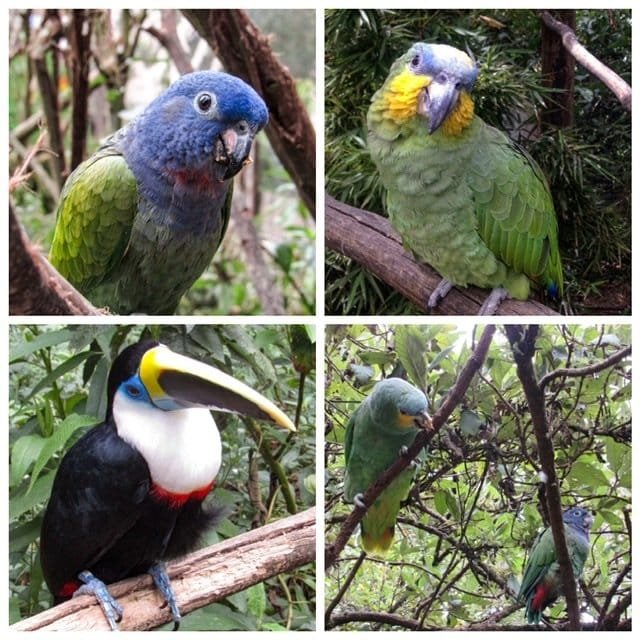
Andean Condor
He may not be pretty, but this native of the Andes provides a useful service as a scavenger. The Andean Condor is one of the largest flying birds in the world. His wingspan can reach over 10 ft (3.3 m). The condor is the national bird of Ecuador and even graces its flag. Amaru has two Andean Condors, a male and a female.

Carunculated Caracara
This bird of prey is a native of Ecuador and lives in parts of the Andes Mountains.

African Clawed Frog or Ghost Frog
These are natives of Africa who were brought to Ecuador as pets. I loved watching them float gracefully, as you can see in this video:
American Bullfrog
These bullfrogs are native to North America and are an invasive species in Ecuador.

Emerald Tree Boa
Snakes aren’t everyone’s cup of tea, but this boa is non-poisonous and looks pretty chill.

I hope you enjoyed meeting just a few of the many species of animals that call Amaru Bioparque home.
The Amaru Bioparque website has a lot of information about the animals in its care. The site has an option for English, but it didn’t work on all the pages. I found it best to Google “Amaru Bioparque” and choose “Translate This Page” so you get every page in English.
Helpful Hints
As of this writing, the park appears to be open. It is open every day except Christmas day from 9 a.m. to 4 p.m. As always, you should verify this information before visiting.
A visit to Amaru is a real bargain. It costs US$ 6.00 for an adult. There are discounts for people under 18 and over 65. The U.S. dollar is the official currency of Ecuador.
In addition to sturdy shoes or boots, be sure to have sunblock and a hat or umbrella (it is Ecuador, after all).
The park is not wheelchair accessible or stroller friendly.
It is best to avoid visiting for a few days after a heavy rain. The paths can become slippery.
The Amaru website suggests you allow 2 hours for your visit. Other articles recommend 4-6 hours. I don’t think 2 hours is anywhere near long enough. We visited twice and spent a total of 8 hours.
The website lists several educational demonstrations that take place on weekends and holidays. I cannot comment on them since both our visits were on weekdays. Also, I would assume that the demonstrations are in Spanish.
A Volunteer Opportunity
If Amaru is your type of place, you may want to look into volunteering there. They require a minimum two-week commitment. Wouldn’t that be a fulfilling experience? You can find information about volunteering on the website under Support Us.
Have you been to Amaru Bioparque? We’d love to hear what you thought about it in the comments below.
Happy traveling,
Linda
Before You Go
If you enjoyed this post, please consider subscribing to Wind and Whim. You’ll get an email notification each time we publish a new post and get our short and sweet monthly newsletter in your inbox, too! If I’ve given you valuable information and you want to show your appreciation, you can buy me a coffee.
